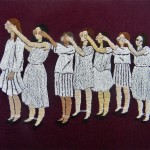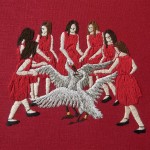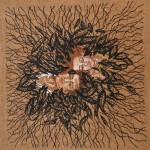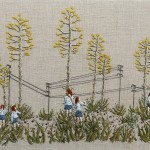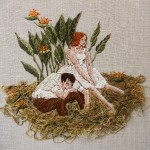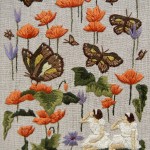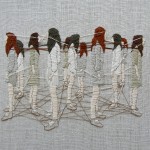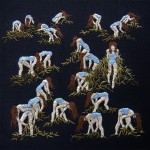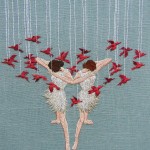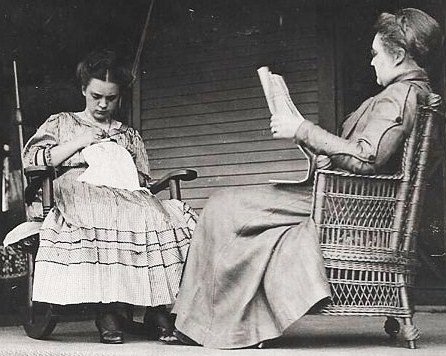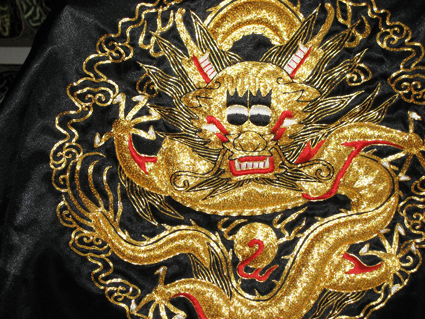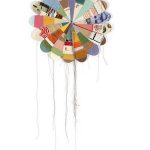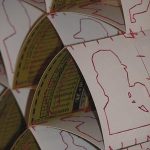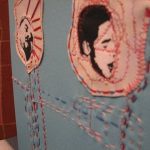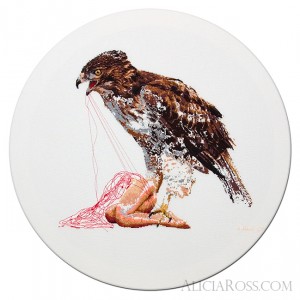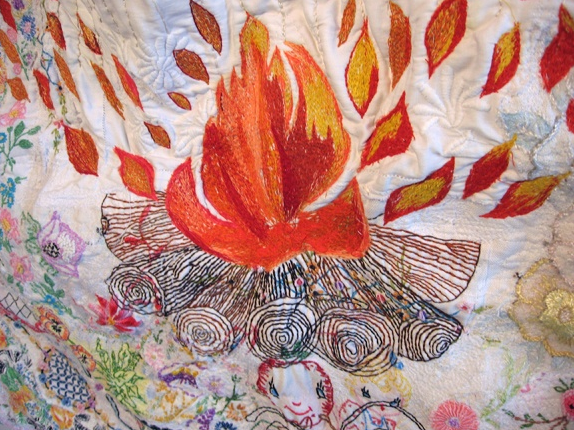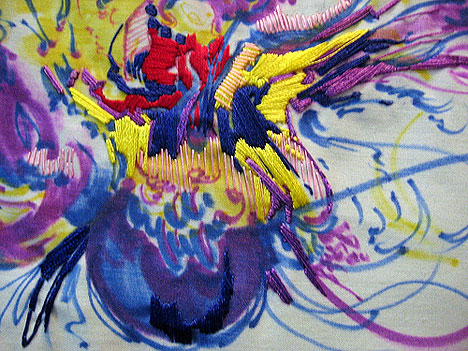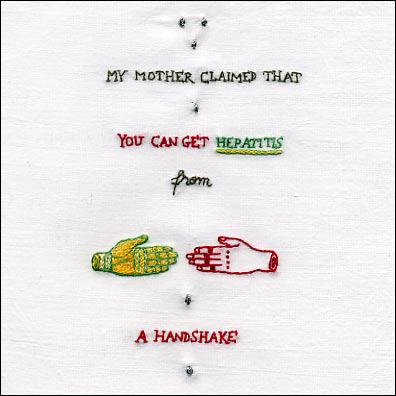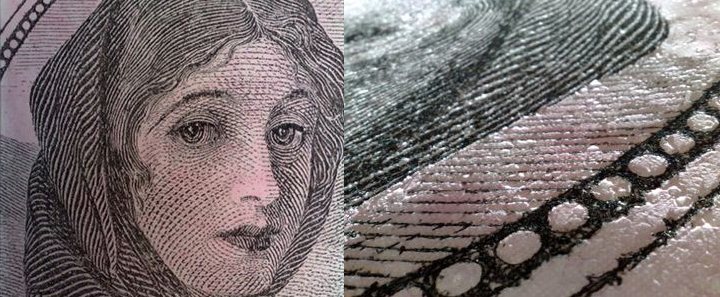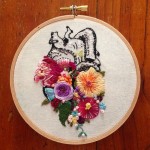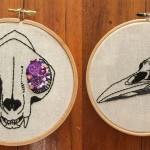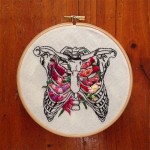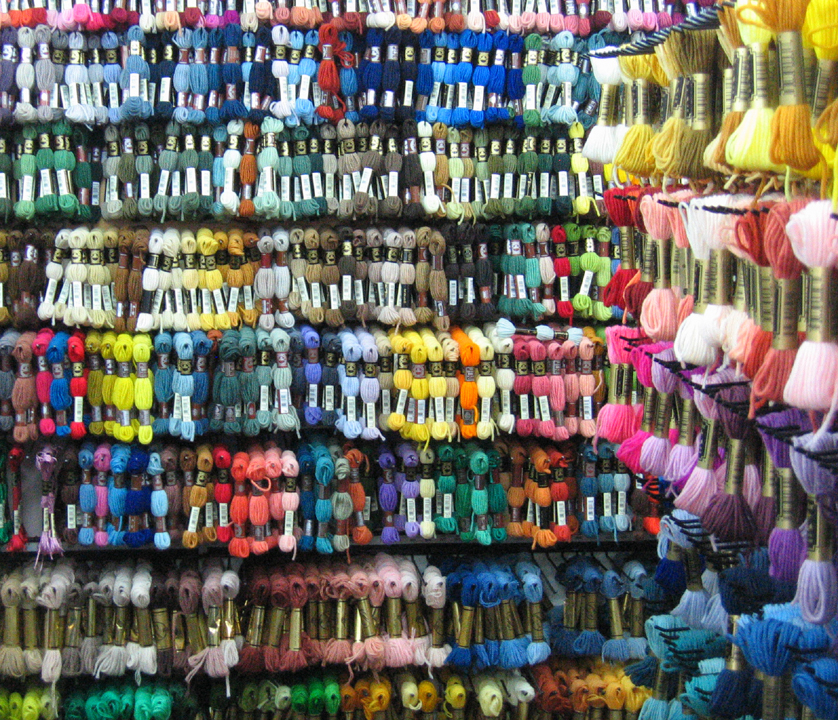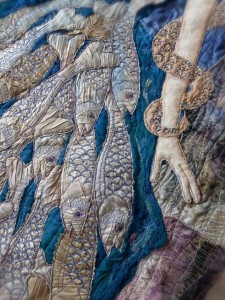
Mary Moorkens Textile Artist. SOURCE: //www.facebook.com/Mary-Moorkens-Textile-Artist-1691354344430656/photos
History of Sewing & Embroidery
Written by Ashley J. Ortiz-Diaz
Sewing and embroidery have been a part of the domestic cultures of many countries for hundreds of years. The women of the early nineteenth century were house wives and mothers and needed to know at least the very basics of sewing in order to be considered a well versed woman. A woman of that time, Eliza Farrar, wrote in 1837 that a woman who cannot sew is like a man who cannot read. [1]
Embroidery on the other hand has its origins in ancient China [2]. The earliest evidence of embroidery is from the Shang Dynasty (16th-11th Century BC). These embroideries could be found on coverings of bronze vases with intricate details and patterns.
Embroidery was more of a decorative art from its beginnings and showcased a person’s wealth and social status. It has also been used to make emblems to differentiate groups. [3] With the invention of the sewing machine (1845) and the computerized embroidery machine along with the industrialization, these crafts were taken to a new level.
Although embroidery has been an artistic medium for centuries, sewing has just recently become a way to draw. Of course, it has been used to make clothing, but to make the sewn line just as one would draw a line is a relatively new idea. There are now many contemporary artist who prefer this media above all else. There have even been a number of exhibitions with this as its theme. In these shows there have been many example of embroidery as well. These two seem to go hand in hand in this new media exploration. Here are a couple of examples of artwork from an exhibition in Arlington, Virginia in 2008. The title of the show was “The Thread as the Line.” Other crafting techniques in the show included quilting and object making. This media lends itself to mixed media practices and experimentation.
- Image Credit: Thomas Campbell
- Image Credit: Graham Childs
- Image Credit: Steve Frost
Sources:
[1] "A 'Truly Feminine Employment': Sewing and the Early Nineteenth-Centruy Woman" by Amy Boyce Osaki
[2] "Embroidery Techniques In Old China" by Schuyler Cammann
The Advantages and Disadvantages of Sewing/Embroidery
Sewing and embroidery is traditionally considered to be more of a craft than an art, but these techniques have become more established in the art world as artists use sewing and embroidery to create illustrations and as an addition to mixed media paintings or textile artworks.
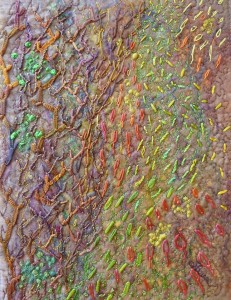
'Springtime' by textile artist Geraldine Beirne; SOURCE: //www.facebook.com/GeraldineBeirneTextileArtist/
There are many reasons why an artist might use sewing or embroidery as opposed to other traditional mediums. With textile art techniques, more emphasis is placed on the material itself. Textile artists use their fabrics and threads to create their aesthetic or narrative. Paula Sanz Caballero, an artist who uses sewing, said, “Everything I know about the material, its possibilities and limitations, comes from my desire to mould it as I please, and thus to tell stories through it.” Embroidery can create “paintings” that are just as vivid and lush as regular paintings.
Sewing also can create a variety of textures depending on what stitch is used. Rebecca Ringquist uses a combination of hand stitching and machine sewing to create her work. According to Ringquist, hand stitching creates neat, orderly lines while machine sewing creates a wile and manic effect.
This is an example of Ringquist’s use of machine sewing to create messy and lively lines.
Embroidery can also be used to add in patches of texture and depth in mixed media paintings. The texture of thread contrasts with more flat mediums like paint.
Finally, sewing and embroidery, because of its history as a traditional craft for homemakers, can be used to make social statements. For example, Rebecca Rinqquist first used sewing as a technique in her artwork after a feminist history class. She aimed to portray ideas about femininity and was excited by the fact that “the material could convey its own very important history and meaning.”
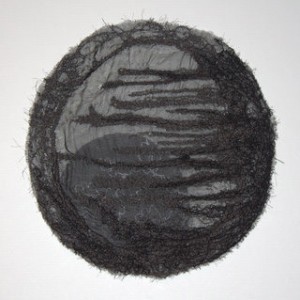
Sara O'Hara; SOURCE: //www.corkcraftanddesign.com/assets/uploads/gallery/soh_looking_through_I-1.jpg
Andrea Dezco also exploits the history and connotations of embroidery to create her art. Dezco creates a new spin on the“sampler,” a piece of linen usually embroidered with religious or moral wisdom. She instead embroiders advice from her mother for a humorous effect.
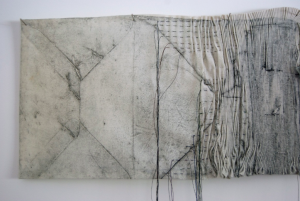
Maeve Coulter, Unfettered (detail) - Collograph Print on Cotton, Pleated & Stitched; SOURCE: //www.maevecoulter.com/textiles/pleated-work/
The greatest disadvantage to sewing and embroidery as a medium is the amount of time it takes to sew, especially for hand stitching. Otherwise, sewing and embroidery is a very versatile technique that can be used to create and utilize textures and textiles that traditional mediums cannot.
written by Charles SommerThere are many different kinds of stitches, all of which can do different things depending on what effect you desire. However the most essential is probably being able to begin and end a stitch. According to the people over at needlenthread.com the “waste knot “ is the easiest way to anchor a thread when beginning a stitch. This method can be used to anchor a stitch that will be straight or a gentle curve. Also it is great for when you need to start a new thread. When the stitch is going to be a tighter curve it is better to use the “ Away waste Knot”.
Ending a stitch is quite simple. In general, once a stitch is completed all you need to do to end a stitch is poke the needle through the fabric to the back. Turn over the fabric and then thread the needle underneath about two inches of the stitch.
Thread is very important so it’s probably a good thing that there are endless varieties of thread. In general when doing embroidery, a 20 to 30-weight thread is the best choice when doing decorative things. However it really depends on what your needs are and there are different weights for different effects. Also it is very important that you choose the correct needle to go with your tread. Some needles can fray your thread if the needles eye is too small. Also a good tip for when you cut your thread is to always tie a knot on the end of the thread that you cut from the spool. This prevents the thread from getting tangled.
Sources:
//www.ehow.com/how_5966_end-embroidery-stitches.html
//www.needlenthread.com/
//www.quiltbug.com/articles/thread-theory.htm//www.quiltbug.com/articles/thread-theory.htm
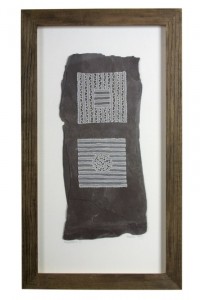
Theresa Kelly- Meditation II; SOURCE: //www.theresakelly.net/Portfolio/Pages/New_Grange_Series.html#0
ASSOCIATIONS WITH SEWING
housewife
grandmothers
doylie
hankerchief
domestic
tacky sweaters
holidays
rocking chairs
the christmas story bunny suit
etsy
clothes
crafts
sequins
childhood
snagging thread
time consuming
soft
traditional
girly
sweatshops
comforting
hobby
kiosks at the mall
variety of color choices
old people
golf
quilting
blankets and stuff
home sweet home plaques
craft shows on TV
Natalie Dee
mexican ponchos
Sewing Readings
Art In Needlework: A book about embroidery
This is an old book about embroidery, and it's all online. It's fun to flip the pages.
ARTICLES:
Sewing Resources
|
VIDEOS: Diagrams and Descriptions:
|
